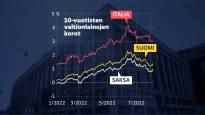Interest rates on 10-year government bonds have declined during the summer, although they were still expected to rise in the spring. According to experts, the drop in interest rates indicates that the economic outlook is becoming increasingly gloomy.
The era of zero interest rates has officially ended, but you wouldn’t notice it at first glance from the interest rate curves of government bonds.
The interest rates on 10-year government bonds have turned downward during the summer, even though the direction was supposed to be the other way around.
The downward direction of interest rate curves is, in principle, a good thing for governments. It means that you can get a new loan at a cheaper price. However, there is some worrying news behind the drop in interest rates.
The interest rate curves of government bonds can be considered a kind of barometer of the economy. Their direction signals the mood of the market and anticipates the future. Now the mood has darkened. The decline in yield curves indicates increasing fears of a recession, according to the experts interviewed by .
— Investors have started pricing government bonds down, which usually indicates a change in expectations. This time it’s probably because the economy is developing weaker than was thought in the spring, says an economist from the Bios research unit Jussi Ahokas.
— Recession risks have increased. It is clear that weaker times are ahead in the economy, says S-Pank’s chief strategist Lippo Suominen.
The economic outlook is especially weakened by concerns about energy sufficiency. The question is what will happen to Russian gas supplies and how Europe will survive the coming winter.
More moderate interest rate increases are expected from the central banks
Movements in government bond yield curves also signal the market’s monetary policy expectations.
Since the economic growth outlook has darkened, investors anticipate that the central banks will not make very drastic increases in their key interest rates. In July, the European Central Bank (ECB) raised its key interest rates for the first time in 11 years and said that the increases will continue in the fall as well. The US central bank FED, on the other hand, has already raised its key interest rates several times.
The central banks are trying to curb record-high inflation, i.e. the rise in prices, with interest rate increases, but too drastic an interest rate increase freezes the economy too much and pushes national economies more and more into recession.
— We still expect the central banks to raise their interest rates, but not as sharply as was predicted in June, says OP’s chief economist Reijo Heiskanen says.
According to Jussi Ahokka, the interest rate market’s movements show that it is not possible to break away from the era of zero interest rates painlessly. He believes that the weak economy cannot withstand raising interest rates, and this message is now also coming from the market.
— Yes, it shows that the central banks are having trouble normalizing monetary policy, so to speak.
Reijo Heiskanen, on the other hand, says that it is not worth drawing any big conclusions from the now visible dip, because the volatility in the interest rate market is great. However, the general direction in terms of interest rates is upwards, says Heiskanen.
— In the big picture, the very low inflation and very low interest rates of the last decade have been left behind. This decade will see at least the targeted inflation and higher interest rates.
For example, on Friday the interest rate market was swayed by the employment figures published by the United States. Employment improved in July more than twice as much as analysts expected. The news turned the yield curve of the US 10-year government bond upwards, as the better-than-expected employment situation reversed expectations about the FED’s next moves and made investors expect even steeper interest rate hikes.
The threat of the euro crisis has not been resolved
As key interest rates rise, particular concern has been directed at the most indebted euro countries, especially Italy, Europe’s third largest economy. The rise in the interest rate on the national debt indicates that the market is concerned about the country’s ability to cope with paying its debts. In June, the interest rate on Italy’s 10-year government bond exceeded four percent, which is only a few percentage points away from the six percent limit considered critical.
Recently, the interest rate on Italian government bonds has also fallen, to around three percent, even though the country is living in politically unstable times.
Still, the worries about a new euro crisis have not dissipated, experts interviewed by say.
The interest rate difference between Italy’s government bond and Germany, for example, is still large. The ECB’s problem is precisely the so-called differentiation of the interest rate market, where the interest rate development of the government bonds of the most indebted euro countries moves at a faster pace than others.
— The problems have not been solved, but support is still constantly needed in order to keep the euro area united, states Lippo Suominen.
The ECB has created a new instrument for this purpose, which is intended to prevent an uncontrolled rise in interest rates on the government bonds of the most indebted euro countries. According to the ECB, the tool will only be introduced if there is panic in the market.
The subject can be discussed until Tuesday, August 9, until 11 p.m.
